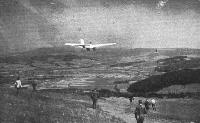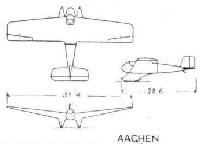
Варианты
- FVA (Flugwissenschaftliche Vereinigung Aachen) - FVA-1 Schwatze Duvel/FVA-2 Blaue Maus/FVA-3 Ente - 1920 - Германия
- Aachener/Klemperer - monoplane - 1923 - Германия
M.Simons The World's Vintage Sailplanes 1908-45
THE SCHWARZE TEUFEL AND BLAUE MAUS
One night in the late autumn of 1920 a goods train with at least one wagon load of illegal cargo left the ancient city of Aachen, close to the Dutch and Belgian frontier of Germany, headed for the equally old but smaller town of Fulda, north east of Frankfurt am Main. Parts of Germany were still occupied by the Allied armies of 1918. Transport of any sort of aircraft through the occupied zones into unoccupied Germany was forbidden. Aachen itself was in the Belgian zone, the British were based on Cologne, whilst the French and Americans held areas to the south. As the train steamed ponderously through the darkness it was subjected to inspection several times by the occupation troops. On board, carefully covered by tarpaulins, guarded and protected by a young student, was the FVA-1, a glider built by the Flugwissenschaftlichen Vereinigung Aachen, the student flying group of the Aachen Technical University. In case any of the troops should take too close an interest, the student carried a box of good cigars with which he hoped to buy them off. Fortunately he never needed to put this notion to the test. The train lumbered on, the tarpaulins undisturbed.
The FVA had built their first flying machine during a frantic period of four months of day and night labor, following the announcement of the first Rhoen gliding contest to be held on the Wasserkuppe. Erich Meyer and Wolfgang Klemperer, the originators, wrote an announcement calling all those interested to the meeting and Oskar Ursinus published it with editorial support in his magazine, Flugsport. Ursinus volunteered to organise the contest and was its director. The contest began in July when the glider was only half completed. The design was by Klemperer himself and the student team was led by Paul Stock. Klemperer, born in Saxony, had been a lieutenant in the Austrian Flying Corps. He had recently taken up a post as assistant to the Professor of Mechanics at Aachen, Theodor von Karman, and in him found another enthusiast and staunch supporter. Von Karman and Klemperer were both convinced that the future of flight lay with the cantilever monoplane. The FVA-1 had a thick cantilever wing with three stiff wooden spars of 'I' cross-section. The central one alone was strong enough to carry five times the normal load but weighed only 7.5 kg for a span of 9.2 metres. The three spars were cross-braced one to another against torsion and light ribs with plywood webs formed the aerofoil section to the Junkers pattern, changing progressively toward the tips. The leading edge was covered with cardboard, the rear section with fabric, and the trailing edge was a length of stiff steel wire. The ailerons were hinged to a light auxiliary diagonal spar. Muslin was used for the covering. Its black color inspired the name, Schwarze Teufel (Black Devil), after a legendary wolf that was said to have manifested itself in Aachen during the time of Charlemagne. The complete wing weighed 24 kg for an area of 15 square metres.
The front fuselage and the undercarriage were built directly onto the wing. The twin ash skids were carried on streamlined ‘spats’. The cockpit was located between the front and main spars, the seat on top of the front spar. The control column was supported in front of this spar, pivoted on a specially built universal joint, with wires running to the ailerons and the elevators. The streamlined form of the fuselage was provided by bamboo hoops and stringers. A normal rudder bar was fitted. The rear section of the fuselage with tail unit complete. was detachable for transport. The rudder was aluminium framed but fabric covered.
After various adventures the glider reached the summit of the Wasserkuppe. The meeting was nearly over and was on the point of breaking up in a general state of gloom. Little had been achieved and one man had been killed. The Schwarze Teufel, however, restored confidence. It had been designed by experienced engineers who were up-to-date with all the latest research and well informed as to the general development of aircraft during the war years. Enough money and time had been put into it to render it truly airworthy.
The Aachen team used, for the first time, a rubber rope or ’bungey' instead of relying on a running start or being towed off by hempen ropes, for launching. This was Klemperer’s idea. The method was a great success and remained for ten years afterward almost the only known way of getting a glider into the air. Klemperer made his first hop on 4th September and broke one of the skids on landing. This was soon righted and on his third flight he covered 1.83 kilometres and flew for two-and-a-half minutes, easily the best flight of the entire meeting.
No-one was sure, at this time, if there would ever be another gliding contest. Probably the one good flight made by Klemperer was what turned the scales, bringing everyone, and more, back to the Wasserkuppe in 1921. The second meeting was attended by some great men. Von Karman, Prandtl, Handley Page, Anthony Fokker and others whose names were greatly respected in the world of aviation. Klemperer and the Aachen students arrived earlier this time, with a new glider, the FVA-2 Blaue Maus (Blue Mouse). The name had nothing to do with the aircraft’s color, which was white. It came from a famous warplane, one of the Rumpler two-seaters, which had been given that nickname by its pilots and crews. The FVA-2 was very similar to the Schwarze Teufel. The cockpit was moved forward a little so the pilot’s seat could be dropped lower in front of the spars, so that he would present less drag in flight by being more enclosed in the fuselage. Detailed improvements to the structure resulted in lower weight.
During August the Schwarze Teufel was flown by students and by Klemperer himself, but did not exceed its best flight of the previous year. On one flight the undercarriage was badly broken and the Schwarze Teufel was retired from further use. Klemperer with the Blaue Maus quickly improved his previous record and even essayed a 360 degree turn, out over the slopes. On 30th August, he set off to glide down to Gersfeld, a long way off, it seemed, down in the valley. He tried to extend his flight by using the upward wind blowing over the slopes, and for a short time he did maintain height before heading off into the vale. He landed close to his target 4.6 km away after flying for 13 minutes 3 seconds. This has been described as the first true distance flight by a glider. As a world record, however, it lasted only one week.
Technical data:
FVA-1: Schwarze Teufel: Span, 9.30 m. Wing area, 15.0 sq m. Aspect ratio, 5.76. Empty weight. 61 kg. Flying weight, 136 kg. Wing loading, 9.07 kg/sq m.
FVA-2 Blaue Maus: Span, 9.70 m. Wing area, 15.50 sq m. Aspect ratio 6.0. Empty weight, 53 kg. Flying weight, 128 kg. Wing loading 8.26 kg/sq m.
Описание:
- M.Simons The World's Vintage Sailplanes 1908-45
- Flight, September 1921
SOARING FLIGHT IN GERMANY - Flight, November 1922
THE KLEMPERER "ENTE"
Фотографии
-
GL / M.Simons - The World's Vintage Sailplanes 1908-45 /Kookaburra/
Wolfgang Klemperer flying the Schwarze Teufel at the 1921 Rhoen competition on the Wasserkuppe, one of the few photographs taken of the machine in flight. The pilot sat on the front wing spar but on the Blaue Maus type the seat was set a little lower. The launch was made by rubber shock cord or ‘bungee’, a method invented by Klemperer. The bungee was a ‘V’ of strong rubber rope about 2.5 cm in diameter. A steel ring was tied to the apex and rope grips were provided at each end for the launching crew to hold as they ran down the slope. The ring fell clear as the sailplane flew over the crew's heads.
-
Flight 1921-09 / Flight
THE RHON SOARING COMPETITION: The Aachen Glider in Flight. This photograph gives a good idea of the nature of the country over which these gliding and soaring flights are being made.
-
Flight 1921-09 / Flight
THE RHON SOARING COMPETITION: Two views of the Aachen glider, which did so well in the turning competition. The attitude and indifference of the cattle indicate that the machine has no engine.
-
GL / M.Simons - The World's Vintage Sailplanes 1908-45 /Kookaburra/
A Blaue Maus at the Ilford Hill meeting, organised by the Daily Mail newspaper in 1922. Three were built in Aachen to the Akaflieg design, one with an extended wingspan and improved performance. The prototype was wrecked by Klemperer himself when attempting a launch from a captive balloon in Switzerland. He was unable to pull out from the resulting spin before hitting the ground but still escaped injury.
-
Flight 1922-10 / Flight
MR. JEYES' AACHEN MONOPLANE: Inset, the machine in flight.
-
Flight 1922-10 / Flight
BRINGING HER BACK: Our photograph shows one way of bringing back a glider to the top of the hill after a flight. The wings are stacked on a German hay cart, the fuselage being trailed behind. The machine shown is the Aachen "Tail-first" monoplane on which Herr Klemperer crashed after getting into a spin when his glider was dropped from a kite balloon.
-
GL / M.Simons - The World's Vintage Sailplanes 1908-45 /Kookaburra/
The FVA-1 Schwarze Teufel under construction in Aachen. The intricate workmanship and complex structure, with many lightening holes, is quite evident. The control column on its special universal pivot was in place but the rear fuselage and tail section had not yet been fitted.
-
Flight 1922-10 / Flight
Aachen
-
Flight 1922-10 / Flight
Aachen Monoplane 1921
-
Flight 1922-11 / Flight
THE KLEMPERER "DUCK": Plan view of the machine, with main dimensions, etc., shown.
- Фотографии










